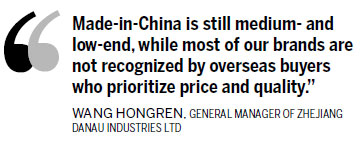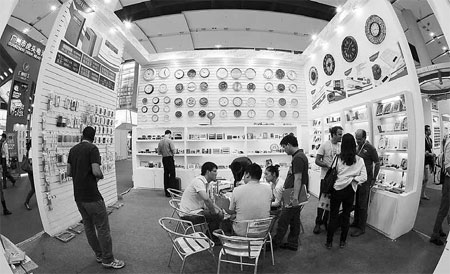Brand, design remain key
Updated: 2013-05-07 07:11
By Li Jiabao in Guangzhou (China Daily)
|
||||||||

|
International traders negotiating deals at Canton Fair. Net exports accounted for 9 percent of GDP growth in 2012, according to the General Administration of Customs. Provided to China Daily |

Under-pressure exporters aim to rekindle fortunes
Chinese exporters are keen to develop a new competitive edge through brand-building and technological development amid grim export prospects this year.
"Export businesses are now finding life much harder than before the financial crisis of 2008," Wang Hongren, general manager of jetting machine company Zhejiang Danau Industries Ltd, told China Daily during the 113th Canton Fair.
The fair opened in Guangzhou on April 15 and closed on Sunday.
Gao Yue, sales manager for international business group Foshan Oceano Ceramics Co Ltd, said: "Our traditional advantage is lower prices than overseas sellers, and bulk shipments to overseas markets earn us remarkable profits despite of narrow profit margins.
"But the traditional advantage is vanishing owing to the rising renminbi and increasing costs for labor, wages and raw materials. Meanwhile, orders from major markets remain sluggish."
Vice-Minister of Commerce and China International Trade Representative Zhong Shan urged exporters during the fair to build up a new competitive edge, supported by technology, branding, quality and services.
Gao said: "Building a brand is a long-term as well as costly process, but is also a step that we must take because we have no other choice for survival."
China is the world's largest exporter and second-largest importer, with expanding trade playing a significant role in its economy.
Net exports accounted for 9 percent of GDP growth in 2012, according to the General Administration of Customs, and the country's foreign trade dependence ratio - the degree of an economy's dependence on foreign trade - dropped 3.1 percentage points to 47 percent in 2012, but still outstripped the 30 percent in the US, Japan and Brazil.
The new leadership outlined an 8 percent trade growth target for 2013 after 6.2 percent growth in 2012 trailed a 10 percent target.
Feng Xuelei, sales director of Ecovacs Robotics (Suzhou) Co Ltd, said: "We are first an original equipment manufacturer for the world's top vacuum cleaner brands, but fierce competition forced us to develop our own product seven years ago - the automatic window cleaner, which we named Winbot."
The company started overseas sales three years ago and has established branches in Los Angeles and Dusseldorf. Overseas orders in the first quarter of this year rose 30 percent from a year earlier and are expected to grow 40 percent for the whole year, much higher than the 25 percent sales growth in 2012, Feng said.
College links
"Independent innovation is the foundation for our own brand," Feng said. "With a research team of more than 200, we invest 5 percent to 10 percent of annual sales each year in technology innovation.
"The innovation and industrial design are all completed jointly with colleges in Nanjing, Jiangsu province."
Wang Hongren said innovation brings pricing power and increased sales to developed markets despite the debt crisis.
"Thanks to the debt crisis, budget-tightened buyers in the US, Japan and EU increased purchases of our products," Wang said.
"The function and external features of our machines are basically the same as the products in Japan or Italy owing to improvements in equipment standards and raw-material use. Despite price increases in recent years, our prices are still competitive or just half those of Japanese products."
The company makes cleaning machines, selling more than 99 percent of its products overseas mainly the US, the EU and Japan. Sales jumped 56 percent in the first quarter from a year earlier and whole-year sales will increase 50 percent to 60 percent, Wang said.
In contrast, Zhang Fenglin, a sales manager at Ningbo A-line Cable and Wire Co Ltd, said the company's overseas sales in the first quarter dropped about 20 to 30 percent year-on-year.
"We are a wire-seller to markets in Mexico, the EU and Australia. Purchases by overseas buyers have fallen significantly this year, while labor costs keep rising. Competition from other countries has also diverted orders," Zhang said.
Maxim Liubarin, China branch director of SimpliCity Design, an Italian design management company established three years ago, said: "As the economic situation changes, Chinese companies are trying to find new ways."
He noted that Chinese companies have a rising awareness of design, and service demand covers corporate identity, visual identity, logo and company style.
"We also provide new services sourcing old Italian trademarks to China. This is the direction we are moving in and it's of very high interest," he added
Dan Ah, president of InterGram Brand Communication, said Chinese manufacturers have to invest in research and design for survival. "That will eventually pay off in the long term."
Filling the gap
James Piao, branch office president of Goth Design, agreed that China has a "huge demand for design service now".
"Chinese local design providers still have quite a big gap to make up. Our prices are on average twice that of local ones as all our design is finished back in South Korea," he added.
Liao Zhiwen, general manager of SixVector Design & Consultant, said: "We are good at commercializing designs with a better understanding of China's manufacturing, equipment and industrial facilities, which is our greatest advantage, while overseas design providers have a better knowledge of overseas markets and the culture of overseas consumers."
Wang from Zhejiang Danau said brand-building should start from the huge domestic market and then target a specific overseas market.
"The core of a brand is the quality and technology. Made-in-China is still medium- and low-end, while most of our brands are not recognized by overseas buyers who prioritize price and quality.
"So brand-building should begin with the domestic market through long-term sales and then expand to overseas markets."
Wang added that China retains a unique advantage in complete support facilities for different industries, which will resist rising costs and back exporters in the process of brand-building.
Du Wei, assistant to the general manager of Ningbo Ningshing Kinhil Industrial Co Ltd, said: "We are using the profit from original equipment manufacturer orders for brand promotion, which costs 5 million or 6 million yuan ($804,000 to $965,000) a year.
"Our next step will be to further cooperate with giant customers in major markets to advance market promotion and product sales, to establish our brand and finally get rid of the OEM business."
According to Gao from the ceramics company, product upgrading and brand-building add to costs and drive up prices, but the huge domestic market secures a satisfactory profit margin.
lijiabao@chinadaily.com.cn
(China Daily 05/07/2013 page17)

 Michelle lays roses at site along Berlin Wall
Michelle lays roses at site along Berlin Wall
 Historic space lecture in Tiangong-1 commences
Historic space lecture in Tiangong-1 commences
 'Sopranos' Star James Gandolfini dead at 51
'Sopranos' Star James Gandolfini dead at 51
 UN: Number of refugees hits 18-year high
UN: Number of refugees hits 18-year high
 Slide: Jet exercises from aircraft carrier
Slide: Jet exercises from aircraft carrier
 Talks establish fishery hotline
Talks establish fishery hotline
 Foreign buyers eye Chinese drones
Foreign buyers eye Chinese drones
 UN chief hails China's peacekeepers
UN chief hails China's peacekeepers
Most Viewed
Editor's Picks

|

|

|

|

|

|
Today's Top News
Shenzhou X astronaut gives lecture today
US told to reassess duties on Chinese paper
Chinese seek greater share of satellite market
Russia rejects Obama's nuke cut proposal
US immigration bill sees Senate breakthrough
Brazilian cities revoke fare hikes
Moody's warns on China's local govt debt
Air quality in major cities drops in May
US Weekly

|

|








